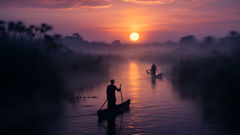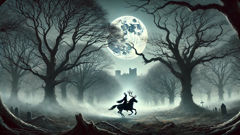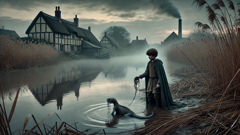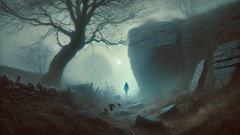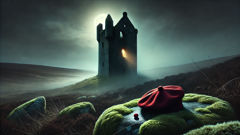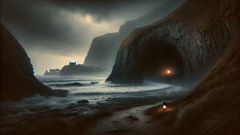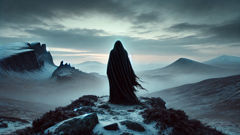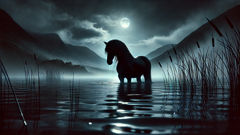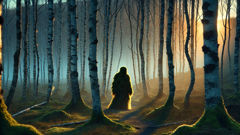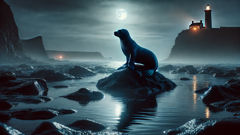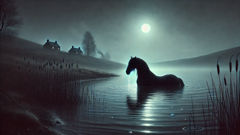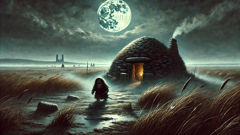Introduction
The Zambezi swamps breathe a life of their own. Under the heavy, humid air, the world feels ancient—older than memory, older than the rivers themselves. Papyrus reeds stand in thick armies, hiding secrets in their shadows. Fishermen's canoes glide across black water under skies streaked with the bruised purples and golds of sunset. In the distance, cries of ibis and the heavy splash of a crocodile ripple through the silence. Yet, beneath the surface of this wild beauty, a deeper current runs: the pulse of legends as old as the people who live here.
Among the Bemba, Lozi, and Lunda, tales pass from mouth to mouth, whispered around smoky fires as the night encroaches. They speak of the Kongamato—the breaker of boats, the bringer of terror from above. Some say it is a spirit, others an animal older than time, its wings casting shadows as wide as canoes, its beak red with the memory of blood. Explorers from distant lands, with their notebooks and curious eyes, come chasing these stories, hoping for evidence, for proof. But for those who call these wetlands home, the Kongamato is not just a legend; it is a presence woven into every creak of the reeds and every glimmer of movement at dusk.
In the year 1923, when the world was changing and the boundaries of the known were being redrawn, a young Zambian guide named Chanda met an Englishman, Professor Ernest R. Hargrove. The professor had arrived with grand ideas and a stubborn skepticism, convinced that science could explain all mysteries. Chanda knew otherwise. He had heard his grandmother’s voice, trembling with fear and awe, tell of the night the sky opened and a creature not meant for this time descended upon the village.
Their journey together would become more than a search for a monster. It would lead them deep into the swamps—into the heart of darkness and the heart of wonder—where myth and reality meet, and where the truth is as tangled and shifting as the reeds themselves.
Chapter One: Whispers in the Papyrus
Chanda had grown up on the edge of the swamps, in a village where everyone knew that the world was more than what the eye could see. His earliest memories were of firelight dancing on his grandmother’s face as she spun stories—some to frighten, others to teach. The Kongamato was both. It was the warning that made children run home before dusk, the explanation for unexplained disappearances, and the reason why fishermen left offerings of cassava and beer on the shore.
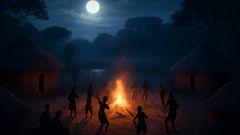
On a morning heavy with promise and the scent of rain, Chanda watched Professor Hargrove step out from the white canvas of his tent. The Englishman was tall, with sunburnt skin and spectacles that slid down his nose. He’d brought an array of tools: notebooks, binoculars, a camera with glass plates packed in straw, and a rifle that he rarely carried but always kept polished. Chanda greeted him with a careful respect. Foreigners were unpredictable, but Chanda sensed that this one was different. He listened—truly listened—when Chanda spoke.
They set out in a battered canoe, paddling through channels that twisted like snakes. The wetlands were alive with sound: frogs croaking in symphony, dragonflies skimming over the water’s skin, the sudden thrash of a hippo submerged nearby. As they traveled deeper, the world grew stranger. Great trees, uprooted by old floods, formed bridges and barriers. In some places, the sky was nearly hidden by a ceiling of leaves and tangled vines. The smell was earthy and green, tinged with rot and sweetness.
Hargrove asked questions endlessly. “How old is the legend?” “Have you seen the creature yourself?” “What makes you believe?” Chanda answered as best he could. He had never seen the Kongamato, but he knew those who claimed to have glimpsed it: a fisherman with scars down his arm, a woman who would not cross the river after sundown, a hunter who swore he’d found footprints bigger than any bird’s. The professor scribbled furiously, but sometimes he would just stare into the murk, lost in thought.
Midday brought a sudden downpour, the kind that transformed the world in minutes. They took shelter beneath a fallen fig tree, sharing dried fish and rainwater. Chanda told Hargrove about the Kongamato’s call—a scream that was half eagle, half something else. Hargrove, amused but respectful, pulled out a sketchbook and drew what he imagined: leathery wings, a toothy beak, a body somewhere between lizard and bird. The drawing made Chanda shiver.
As dusk painted the swamps in violet and silver, they reached a remote village where an old man named Mwansa lived. He was known as a keeper of stories and was said to have survived a Kongamato attack in his youth. Mwansa’s hut was smoky and crowded with charms: dried claws, feathers, tiny woven baskets filled with river stones. He welcomed them with a gaze sharp as a spear’s point.
“You come for the truth,” Mwansa rasped, “but truth is a thing with wings—it does not always land where you expect.” He told them his tale: of a night when the air itself seemed to tremble, when he’d seen a shadow blot out the moon and heard the wind thunder with wings. He’d been struck, knocked into the water, and when he woke, his chest was marked with three deep gouges. “It is not a bird,” Mwansa warned. “It is not of this world.”
Hargrove pressed for details. Was it possible that the Kongamato was a misidentified stork? A crocodile’s tail in the dark? Mwansa smiled with pity. “Some things do not wish to be explained.” As they left, Chanda noticed the old man clutching a pouch of ochre and muttering a prayer to the spirits.
That night, the village held a dance to honor ancestors and ward off evil. Drums beat like the heart of the swamp, and flames leaped skyward. Hargrove took photographs, but Chanda felt uneasy. The air was charged, as if something watched from just beyond the circle of light. A child screamed—some said she’d seen red eyes in the reeds. The elders poured millet beer on the ground and sang louder.
Later, Chanda dreamed of wings unfolding across the sky, eclipsing the stars. He woke before dawn, heart pounding, the echoes of the legend as real as the sweat on his brow. In the darkness, he wondered if some truths were better left undisturbed.
Chapter Two: Through the Heart of Shadows
At dawn, mist curled low over the water, ghosting around the canoe as Chanda and Hargrove paddled deeper into the wetlands. The silence was profound, broken only by the distant wail of a fish eagle and the drip of water from oar blades. Here, the swamp seemed endless. Paths vanished behind them, swallowed by shifting fog. Hargrove scanned the sky, hoping for a glimpse of some prehistoric avian; Chanda watched the water, alert for ripples that could mean crocodile or worse.
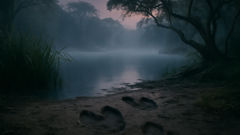
They passed abandoned fishing camps and islands overgrown with wild banana. Occasionally, they found evidence of recent passage—a net tangled in a root, a clay pot half-submerged—but no people. The further they traveled, the more Chanda sensed a kind of wariness in the landscape, as if even the birds and monkeys kept quiet in respect for whatever else lived here.
Late in the morning, they reached a place where the river split into countless tiny channels, each choked with lilies and creeping vines. Hargrove wanted to press on; Chanda hesitated. "We are near Chitambo Island," he said. "My grandmother told me this is sacred land. Spirits walk here."
Hargrove was undeterred. “The best discoveries are always just beyond where others dare to go.” Together, they maneuvered the canoe through a gap in the reeds and entered a lagoon so still it mirrored the sky. There, on a muddy bank, they found strange tracks—three-toed, long as Chanda’s arm, pressed deep into the silt. Hargrove crouched to measure them, excitement shining in his eyes. He photographed the prints, made sketches, and collected samples of mud.
A sudden scream shattered the quiet—a sharp, metallic sound that seemed to come from everywhere at once. Birds exploded from the trees. Chanda gripped his paddle, heart hammering. Hargrove lifted his camera, scanning for movement. Overhead, a shadow flickered against the clouds, then vanished. The water rippled with something huge passing underneath.
They drifted into a channel where the air was thick with the scent of decay. A flock of marabou storks watched them pass with unblinking eyes. Chanda muttered a prayer to the river spirits. Hargrove, pale but determined, whispered, “It’s real. I can feel it.”
By late afternoon, they reached a narrow spit of land where they made camp. Hargrove catalogued his findings while Chanda gathered wood. The Englishman was feverish with curiosity, filling pages with notes: “Wingspan estimate: 12-14 feet. Beak likely hooked. Locals report fear, not reverence.” He theorized about relic populations of prehistoric creatures or undiscovered birds.
Night fell fast. Insects shrilled, and somewhere close, a baboon barked. They ate in silence. When Hargrove finally slept, Chanda kept watch by the fire. The darkness pressed close. Once, he thought he heard the rush of great wings overhead, but when he looked up, only stars filled the sky.
In his dreams, Chanda saw the Kongamato—its eyes burning like coals, its wings stirring storms. It called his name in a voice like thunder. When he woke, he found Hargrove sitting by the dying embers, gazing into the blackness. “Do you believe it now?” the professor asked softly.
Chanda nodded, unable to speak. In that moment, belief bound them together—two men from different worlds, united by awe and fear.
Chapter Three: The Night of Wings
The final test came on a night thick with heat and expectation. They camped on a spit of land hemmed in by black water and towering reeds. The air was charged, and even the frogs were quiet. Chanda sensed that something was drawing near—a force older than language, summoned by curiosity and trespass.
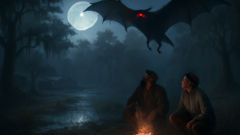
Hargrove set up his camera facing the open sky, its shutter ready to snap at the faintest movement. Chanda prepared charms: an amulet of crocodile teeth, a pouch of river sand blessed by Mwansa, and a strip of red cloth—an offering to appease what could not be named. He scattered millet on the ground and whispered the words his grandmother had taught him.
A wind rose from the east, rustling the papyrus. The moon struggled behind a veil of clouds, painting the world in shifting silver and black. Hours passed. Chanda drifted between waking and dreams, where shadowy wings brushed against the stars. Hargrove dozed fitfully beside his tripod.
Just before midnight, the silence broke—a cry split the air, sharper than any bird’s call. The reeds parted, bowing as if pressed by a giant’s hand. Something vast and dark swept overhead, its wings stirring a rush of wind that flattened the grass. Chanda fell to his knees. Hargrove stared upward, mouth open in shock.
The Kongamato hung in the air above them: massive, with skin stretched taut over bone, red eyes glowing in its skull-like head. Its wings beat with a sound like thunder mixed with the tearing of cloth. The creature swooped low, casting their camp in total darkness for a heartbeat. Hargrove’s camera flashed—the light briefly illuminating scales and hooked claws before the beast twisted away into the night.
The moment passed as quickly as it had come. The Kongamato vanished into the maze of reeds, leaving behind only a memory and the echo of its scream. Chanda’s heart raced; Hargrove trembled with exhilaration and fear.
When dawn came, they found the ground churned where the creature had landed—deep gouges in the earth, broken reeds snapped like matchsticks. Hargrove developed his glass plate with shaking hands. The image was blurred, but there—a shape in mid-flight, huge and impossible, wings outstretched.
For days afterward, they wandered the swamp in a daze. News spread among the villages: two men had seen the Kongamato and survived. Some called them blessed; others whispered they’d brought a curse. Chanda’s dreams were filled with stormy skies and blood-red wings; Hargrove wrote furiously to colleagues in London, trying to capture an experience that defied science.
When they finally left the swamps behind, both men were changed. Hargrove had come seeking answers but left with awe and humility. Chanda carried with him a deeper respect for stories—knowing now that some things live between worlds, refusing to be tamed by logic or explanation.
Conclusion
Years passed, and the world crept closer to the Zambezi swamps—roads laid through once impenetrable wilds, radios bringing news from distant cities, old stories slowly fading beneath new realities. Yet the legend of the Kongamato endured. Some said it was just a tale for children or a misremembered sighting of storks and bats. Others whispered that it still flew by night, guardian or omen, a piece of the ancient world refusing to vanish.
Chanda grew old and became a keeper of stories himself, telling wide-eyed children about the night when the sky split open and something impossible touched down on earth. He never claimed to understand what he’d seen, only that it had changed him forever. Hargrove’s notes and photographs became the stuff of debate among cryptozoologists and skeptics alike—a blurry image, a collection of footprints, an entry in some half-forgotten journal. But to those who listened closely, the message was clear: not every mystery begs to be solved. Some are meant to remind us of how much we have yet to learn—and how small we are beneath the endless sky.
On certain nights, when mist curls low over the swamps and the air is thick with the scent of rain, villagers still gather by firelight. They tell each other to come home before dusk, to leave offerings on the shore, and to listen for the scream that is not quite bird, not quite wind. In these moments, the Kongamato lives on—not just in the darkness above the Zambezi, but in every heart that dares to wonder what waits in the shadows beyond the reeds.

